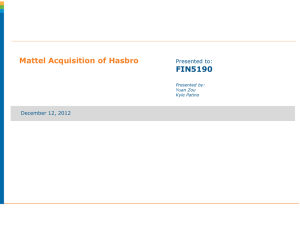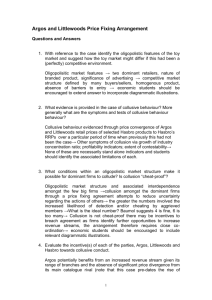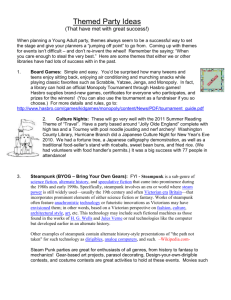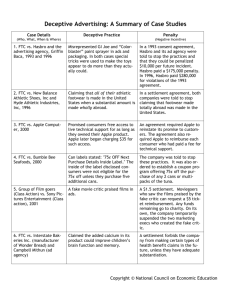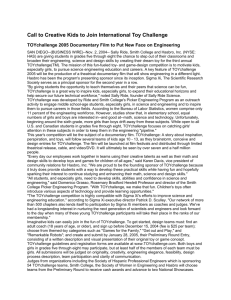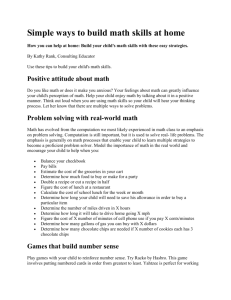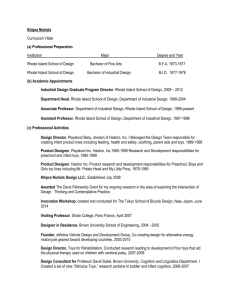Hasbro Business Level Strategy 1
advertisement
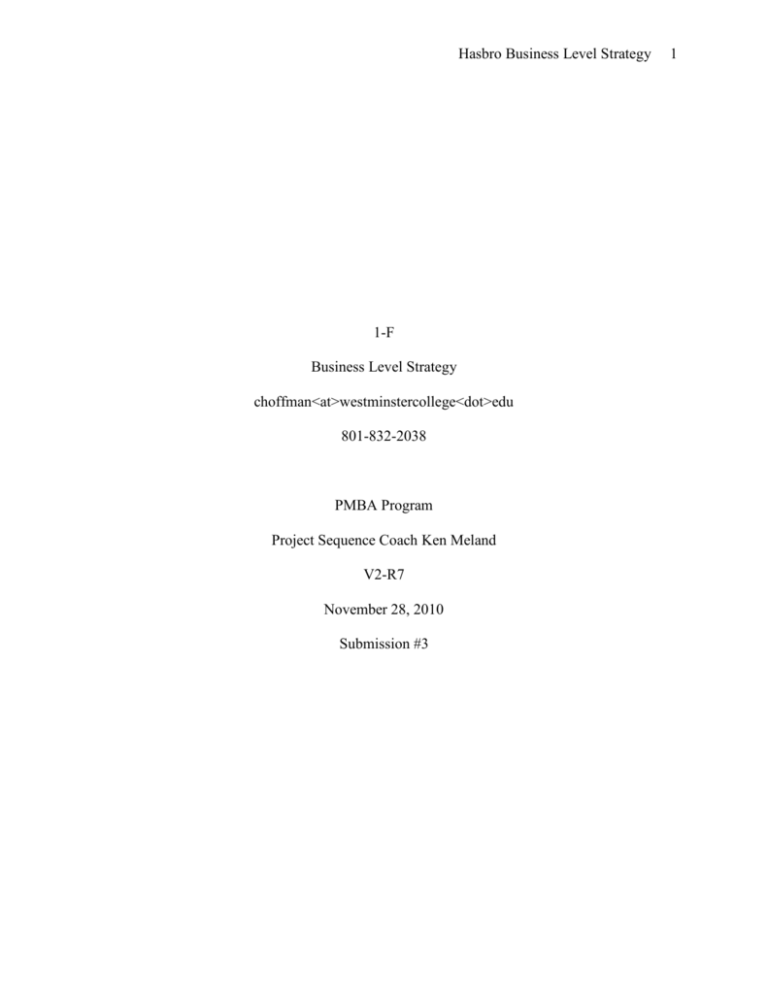
Hasbro Business Level Strategy 1-F Business Level Strategy choffman<at>westminstercollege<dot>edu 801-832-2038 PMBA Program Project Sequence Coach Ken Meland V2-R7 November 28, 2010 Submission #3 1 Hasbro Business Level Strategy 2 Executive Summary Hasbro Inc. has made great investments in its TV Channel “The Hub” and in licensing its properties to market leaders in other media. They should make the most of these investments by seeking out the best creative teams to produce content. Hasbro should also minimize the threats posed by their dependence on China. They should avoid recalls by vigorously enforcing safety standards and be ready to move facilities if rising wages and currency wars make manufacturing in China unprofitable. Hasbro should also start picking up licenses to replace revenue lost in case they lose licenses they don’t own. It is recommended that Hasbro continue a best-cost best-value approach as their main business-level strategy. This allows them to grab many consumers across several ages and genders. Hasbro Business Level Strategy 3 Hasbro Inc., manufacturer of toys and games, has many strengths and weaknesses it needs to address if it wants to claim the top spot from rival Mattel. Hasbro’s strengths are as a market leader in logistics, innovation and brand variety. On the flip side, some of their weaknesses stem from their dependence on China for manufacturing. The following is a SWOT analysis of Hasbro followed by a recommendation of which business-level strategy is their best for the company moving forward. SWOT Analysis Greatest Strength Hasbro owns the licenses to many leading brand names in the toy and game industry. Transformers, NERF, Tonka, Super Soaker, G.I. Joe, Milton Bradley, Parker Brothers, Cranium, Strawberry Shortcake, My Little Pony and Wizards of the Coast. They also currently possess exclusive contracts to produce toys based on Marvel Super-Heroes (Spider-Man, Iron Man, XMen) and Star Wars. Greatest Weakness Having most of its manufacturing done in China constrains Hasbro to many issues that are out of their control. China is notorious for manipulating its currency, corruption and loose safety standards. Navigating these issues takes away precious time and money that Hasbro could be investing in market expansion or research and development. Opportunities TV Channel (The Hub) Before the 1980s, children’s television was heavily regulated by the federal government. Marketers weren’t allowed to make Saturday morning cartoons based solely on selling toys. During the Ronald Regan administration, these rules were deregulated with the idea that the Hasbro Business Level Strategy 4 market would decide what to allow children to watch. Transformers and G.I. Joe were two of the big winners of that policy change. Hasbro took the next logical step in following Disney XD’s lead by starting their own network populated with shows featuring Hasbro properties. The Hub launched on 10/10/10 and according to their press release: “The Hub…garnered significant ratings gains in virtually all dayparts and target demographics over the performance of Discovery Kids Network, the network it replaced, according to Nielsen Media Research.” (The Hub, 2010). The Hub is an opportunity because it creates a platform for Hasbro to reach many customers across several different media channels. The Hub will run programming based on Hasbro properties to capture the market of children who still watch TV. It will also cater to kids who consume media on different devices by offering web content and episodes available on online retailers like iTunes. To take full advantage of this opportunity, Hasbro needs to become good at running a network very quickly. The wrench-turning can be done competently enough by the veteran Discovery Kids crew. The key competency Hasbro needs to improve is identifying and hiring the best creative teams to create compelling stories for their shows. Having Transformers ran 24 hours a day won’t translate into sales unless consumers find the content interesting. Today’s young TV viewer requires top-notch entertainment to pay attention above the noise. Licensing Partnerships Hasbro has great licensing partnerships with Universal Studios, EA Games, Del Rey Books, and IDW Publishing among others. These partnerships cover many dimensions of playtime that enhance Hasbro properties. Universal Studios are planning many movies based on Transformers, G.I. Joe, and Battleship. They have been the “Must-See” blockbuster summer movies of the last few years. At the same time, mistakes made by the filmmakers can leave fans with negative emotions towards the brand. USA Today wrote, “Revenge of the Fallen was … Hasbro Business Level Strategy 5 clearly very popular, though complaints from some moviegoers and a negative fusillade from critics made the filmmakers take notice (Breznican, 2010).” Even though the movie was popular with the masses, its departure from the source material could drive away hard-core fans that support the brand even when there is no movie in theaters. EA Games has a solid line-up of video games featuring Hasbro board games and movie tie-ins. Similar to the issues with the movies, poorly done video games can have a negative effect on fans and fail to bring in new consumers. For example, the G.I.Joe: Rise of Cobra tie-in video game was an unmitigated disaster. The game only sold 160,000 copies worldwide and video game reviewer for TV channel G4TV Matt Keil wrote in his review: “G.I. Joe: The Rise of Cobra is the new gold standard for lazy and uninspired cash-in licensed games. (Keil, 2009)” DelRey and IDW Publishing have been putting out paperbacks and comic books that span the storylines between the movies. These partnerships harness the storytelling skills of these already successful companies. Similar to the TV channel skill Hasbro needs to ensure that their partners are producing top quality material. Threats Recalls Product recalls are a reality for all toy makers and Hasbro has had its fair share. In 2008, Hasbro property Cranium recalled 38,000 copies of Cranium Cadoo Board Games for excessive lead (U.S. Consumer Product Safety Commission, 2008). They also recalled 330,000 Nerf NStrike Recon Blasters because a plunger mechanism would catch children’s skin on their arms, hands and chest (Hasbro Inc., 2008). These recalls are minor compared to the recalls competitor Mattel faced in 2007 in which 9 million toys were affected. Recalls are a direct threat to the company’s revenues. Because toys and games are mostly purchased for children, parents have high expectations for product safety. When a product betrays that trust with a safety recall, Hasbro Business Level Strategy 6 consumers will wonder which other products were marketed as safe when they were not. When this happened to Mattel, the U.S. government even got involved calling for stricter safety standards for all toys being imported to America. To minimize this threat, Hasbro needs to make sure that safety standards are strictly enforced at their China and U.S. facilities. This is a key competency they already have, but it’s one that’s easy to put on the chopping block when management is looking around at cost-cutting measures. Declining Margins Many factors are responsible for the toy industries declining margins. For example, toys and games require ever increasing technological advances in manufacturing and materials, this slowly shaves away at profit margins. Also, rising wages and currency wars in China are also eating into Hasbro’s bottom line. Hasbro needs to be ready to pull the trigger on moving their manufacturing to a cheaper country, like India, if the costs of remaining in China get too high. The toy industry depends on very few customers to carry their product. Hasbro’s three largest customers Wal-Mart, Target and Toys ‘R’ Us account for around 50% of their net revenues (HASBRO INC - FORM 10-K, 2010). Because they rely so heavily on so few customers, Hasbro has less leverage to negotiate higher prices. The key competency Hasbro needs to develop is expanding its brand into more and emerging markets. This will allow them to offset unrealized revenue from their weak bargaining position with North American distributors. Hasbro recently opened an office in Moscow, Russia “saying they expect their share in the country's $1.5 billion toy market to grow significantly." (Bloomberg, 2009). They are also circumventing third-party distributors in growing markets such as Asia, Europe and South America by opening their own brick and mortar stores in those markets (Heinzl, 2010). Hasbro should continue this trend as well as continue perfecting their online, direct-to-consumer websites. Hasbro Business Level Strategy 7 Licenses They Don’t Own Hasbro currently produces many products of properties owned by other companies. Toy lines like Star Wars and Iron Man depend on theater releases of big movies to drive sales. Once the contracts for these properties are up the competition is fierce. If Hasbro lost these licenses, it would drop their profits significantly. In 1991 Hasbro ended it’s licensing of Star Wars products, saving them $100,000 a year (Serwer, 1997). This decision was a huge mistake that Hasbro would come to regret. They had to fight for the license six years later against competitors like Galoob, Mattel and McFarlane Toys. Hasbro’s new deal cost $600 million and a 7.4% stake in Hasbro stock for a contract to produce Star Wars merchandise through 2018 (Answers.com). To minimize this threat, Hasbro needs to court the license holders and search for other licenses to replace current ones. Business-Level Strategy Hasbro’s strategy is to extend core brands, create new toys and games, and take full advantage of efficiency. The best-cost best-value approach positions Hasbro to concentrate on several market segments across many age and gender sectors. Best-cost is a focus of Hasbro’s because many companies could (and do) offer toys and games at much cheaper prices. Several companies offer 3 ¾” military figures that, to the untrained eye, could pass as members of G.I. Joe but Hasbro knows fans will pay a premium for official Snake Eyes, Storm Shadow and Cobra Commander action figures. Also, kid’s eyes don’t light up on Christmas morning quite the same way for “Space Action Knight Man” as they do for a Darth Vader. Although Hasbro uses best-value as their strategy, concentration on efficiency means that they can keep the prices of toys and games low while still maintaining inventory quantities. From Hasbro Business Level Strategy 8 manufacturing competencies and order processing to importation from the Far East, efficiency along the entire supply chain helps Hasbro boost profits. Hasbro also concentrates on a focused market rather than a broad market because not everyone plays with toys and games. Toys and games are a luxury enjoyed the middle and upper classes. In other words, Hasbro’s main customers are families with disposable income. It is doubtful Hasbro dismisses any customers out of hand, but they’re also not trying to make Monopoly a commodity like dishwashing liquid. Steps to Improve Competency For the steps to improve competency section, this paper will focus on Hasbro’s licensing partnerships opportunity. The key competency Hasbro needs to improve is to take full advantage of the opportunity is: Having a process in place that ensures top-notch quality products from its licensing partners. 1. Seek out and partner with market leaders: Hasbro shut down its software division, Hasbro Interactive, after they realized they were not good at being a software company. Recognizing their own weakness, Hasbro has partnered with EA, a market leader in software game development and makes many games based on licenses from movies and games. Hasbro has made similar deals with market leaders Universal Pictures, Del Rey Books and IDW Publishing. Hasbro should continue to partner with industry leaders to make supporting products for their properties. 2. Hire Employees with an Otaku for their Products: Otaku is a Japanese word for a person who is more than just a fan of their favorite passion. Otaku obsess over their fascination and pays particular attention to details. A person with an Otaku for model WWII airplanes would know everything about WWII planes, their construction, what Hasbro Business Level Strategy 9 glue works best, when new models come out, etc. In his book “The Purple Cow” Seth Godin asks: “How good would Pop-Tarts taste if the person in charge of them was the kind of person who ate them for dinner?” (Godin, 2003) What kind of Transformers would Hasbro make if the person in charge of them had their own huge collection? How would Monopoly improve if the person in charge played it every day? Would My Little Pony have more products succeed if the person in charge of them has been collecting them since childhood? Ensuring Otaku in charge of the creative side of these products would harness their obsession into great innovations and product sales. 3. Get Customer feedback: Fans of Monopoly, Transformers, Nerf and The Littlest Pet Shop regularly convene online in message boards, blogs and Facebook groups to discuss the finer points of their favorite products. It has never been easier than now to get instant and honest customer feedback. Getting great at listening to fans and getting to their wants and needs is imperative to Hasbro’s continued success. Hasbro should appoint a communication/social media tsar whose job would include heading a team of Otaku to have conversations with fans to get to the heart of issues consumers have in mind. 4. Make Adjustments: Large companies are notorious for not changing course even when the writing was clearly on the wall. AT&T (Richman, 2004), Blockbuster (Rayburn, 2010), GM (Newmark, 2008) and K-Mart (Longo, 2002) all let the signs of their impending doom linger way too long and, for some of them, beyond any chance of taking corrective action. In the example of Blockbuster, smaller more nimble companies like Netflix and Redbox are slowly eating away at market share with behavior changing new products and, with no new digital media strategy in place, Hasbro Business Level Strategy 10 Blockbuster’s business model is looking like a dinosaur. Hasbro needs to make adjustments based on consumer behavior. More companies, like Lego and Mattel, are entering the board game market which has been dominated by Hasbro products for years (Muller, 2009). Hasbro should immediately have their communication tsar and a team of board game otaku out talking to board game fans about their reaction to these new competitors. Failure to recognize trends like that could lead to a fate like GM’s (without the bail-out.) 5. Story Arc Information/Continuity: With so many companies working on the storyline for the various properties, contradictions might become a problem. Hasbro needs to ensure continuity by having a database of characters and their personality traits. Licensees could be given access to this database and the freedom to add or remove information with a link to where the changes were made. A team of otaku could administrate this database again harnessing the power of something they would love to do anyway. Keeping Hasbro’s core audience happy will go a long way to keep them as advocates and ambassadors for the brand. 6. Seek Out and Support New Storytelling Mediums: Products like the Kindle, iPad, Zune, and Silverlight are all fertile grounds for new storytelling techniques. Currently media creators are only using these technologies to display their current media on a different device. Hasbro should take the initiative and try to create new ways to tell stories on these devices. For example, books with a soundtrack attached that changes in different scenes, Comic books that allow the reader to determine the outcome and virtual browsers with augmented reality that make the story happen in your living room or office depending on which toy you own. Hasbro should support R&D on Hasbro Business Level Strategy 11 these different mediums so that they are on the forefront and experts of emerging technology. Hasbro has the challenge of continuing the successes of the last few years into the future. They have the Midas touch right now, but Hasbro knows G.I. Joe and Transformers won’t pay the bills forever. Hasbro Business Level Strategy 12 Bibliography Answers.com. (n.d.). Hasbro. Retrieved 12 05, 2010, from Answers.com: http://www.answers.com/topic/hasbro Bloomberg. (2009, 09 24). Hasbro Opens Moscow Arm. Retrieved 12 09, 2010, from The Moscow Times: http://www.themoscowtimes.com/business/article/hasbro-opens-moscowarm/384092.html Breznican, A. (2010, 11 06). Next 'Transformers' is due for a switch. Retrieved 12 02, 2010, from USA Today: http://www.usatoday.com/life/movies/news/2010-06-11Transformers11_ST_N.htm Godin, S. (2003). Purple Cow, New Edition: Transform Your Business by Being Remarkable. London: Penguin Books. HASBRO INC - FORM 10-K. (2010, 24 02). HASBRO INC - FORM 10-K - February 24, 2010. Retrieved 11 06, 2010, from faq.com: http://www.faqs.org/secfilings/100224/HASBRO-INC_10-K/ Hasbro Inc. (2008). Recalls to Repair Nerf Blasters. Retrieved November 25, 2010, from Hasbro: http://www.hasbro.com/customer-service/recall/Recall-Nerf-Recon-CS-6-Blaster.cfm Heinzl, J. (2010, 11 08). Playing the Market: Why Hasbro is Hot. Retrieved 12 09, 2010, from The Globe and Mail: http://www.theglobeandmail.com/globe-investor/investmentideas/john-heinzl/playing-the-market-why-hasbro-is-hot/article1790765/ Keil, M. (2009, 08 06). G.I. Joe: The Rise of Cobra Review - Xbox 360. Retrieved 12 02, 2010, from G4TV: http://g4tv.com/games/xbox-360/57082/gi-joe-the-rise-of-cobra/review/ Hasbro Business Level Strategy 13 Longo, D. (2002, 02 01). Poor Communication, Tactical Missteps Forced Bankruptcy. Retrieved 12 05, 2010, from allbusiness.com: http://www.allbusiness.com/retail-trade/43012211.html Muller, L. (2009, 04). Is Hasbro's Cash Cow Being Led to Slaughter? Retrieved 11 06, 2010, from Toy Directory Monthly: http://www.toydirectory.com/monthly/article.asp?id=3680 Newmark, E. (2008, 12 02). Mean Street: Why GM Is Doomed. Retrieved 12 05, 2010, from Wall Street Journal: http://blogs.wsj.com/deals/2008/12/02/mean-street-why-gm-isdoomed/ Rayburn, D. (2010, 04 08). Blockbuster Is Doomed. Retrieved 12 05, 2010, from Businessinsider.com: http://www.businessinsider.com/blockbuster-is-doomed-2010-3 Richman, D. (2004, 09 21). The fall of AT&T Wireless. Retrieved 12 05, 2010, from Seattlepi: http://www.seattlepi.com/business/191742_attw21.html Serwer, A. E. (1997, 08 18). WHO GETS WHAT IN THE STAR WARS TOY DEAL GEORGE LUCAS, BILLIONAIRE DREAM-WEAVER, ANOINTS HIS LICENSEES. Retrieved 12 05, 2010, from Money.CNN.com: http://money.cnn.com/magazines/fortune/fortune_archive/1997/08/18/230223/index.htm The Hub. (2010, 10 12). THE HUB TV NETWORK PREMIERES TO STRONG AUDIENCE GROWTH. Retrieved 11 16, 2010, from Discovery.com: http://press.discovery.com/us/hub/press-releases/2010/hub-tv-network-premieres-strongaudience-growt-931/ U.S. Consumer Product Safety Commission. (2008, January 17). Cranium Cadoo Board Games Recalled Due to Violation of Lead Paint Standard. Retrieved 11 25, 2010, from U.S. Hasbro Business Level Strategy Consumer Product Safety Commission: http://www.cpsc.gov/cpscpub/prerel/prhtml08/08169.html 14

